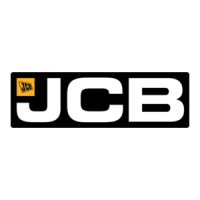Maintenance
Fault-Finding
127 9831/0650-3 127
WARNING: Fine jets of fluid at high pressure can
penetrate the skin. Keep face and hands well clear of
pressurised fluid and wear protective glasses. If fluid
penetrates your skin, get medical help immediately.
Intake air or exhaust leaks. Refer to Table 34. and Refer to Table 35.
Engine compression low in one or more cylinders. Check the engine compression.
Electrical sensor fault. Check the electrical connections at the sensors.
One or more fuel injector worn or malfunctioning. Check the electrical connections at the injectors.
Inlet and exhaust valve clearances set incorrectly. Set the valve clearances to the recommended clear-
ances.
Table 38. Fuel/Oil - Leaking from Exhaust Manifold
Cause Remedy
Operating for extended periods under light or no load
conditions.
Review operation for correct gear shifts, deceleration
and idling.
Intake air or exhaust leaks. Refer to Table 34. and Refer to Table 35.
Turbocharger lubricating oil drain line obstructed. Check/clean line.
Exhaust leak at the Manifold or Turbocharger Check/correct leaks in the manifold or turbocharger
gaskets. Look for a cracked manifold.
Valve guide seals are leaking. Replace valve guide stem seals as required.
Electrical sensor fault. Check the electrical connections at the sensors.
One or more fuel injector worn or malfunctioning. Check the electrical connections at the injectors.
Lubricating Oil
Table 39. Lubricating Oil - Consumption Excessive
Cause Remedy
Oil leaks. Inspect the engine for visible signs of leaks. Pay par-
ticular attentions to seals, gaskets oil cooler and ex-
ternal connections.
Oil level over-full. Check oil level.
Make sure the correct lubricating oil is being used.
Refer to Fluids, Lubricants and Capacities
Check for reduced viscosity from dilution with fuel.
Fuel dilution in lubricating oil can originate from a de-
fective fuel injection pump driveshaft seal.
Incorrect lubricating oil (specification of viscosity).
Review/reduce the lubricating oil change intervals.
Crank case ventilation (CCV) system blocked). Check the breather tube area for signs of lubricating
oil loss. Check and if necessary replace the CCV fil-
ter.
Lubricating oil cooler leak. Check for lubricating oil in the coolant.
Turbocharger leaking lubricating oil to the air intake
or exhaust (if fitted).
Inspect the air crossover tube for evidence of lubri-
cating oil transfer.
Valve guide seals are leaking. Replace valve guide stem seals as required.
Piston rings not sealing - lubricating oil being con-
sumed by the engine (blue smoke from exhaust).
Check the engine compression.
Worn cylinder bores - lubricating oil being consumed
by the engine (blue smoke from exhaust).
Check the engine compression.
Glazed cylinder bores. De-glaze bores as required.
Table 40. Lubricating Oil - Contaminated
Cause Remedy
Coolant in the lubricating oil, internal engine compo-
nent leaks.
Refer to Table 43.

